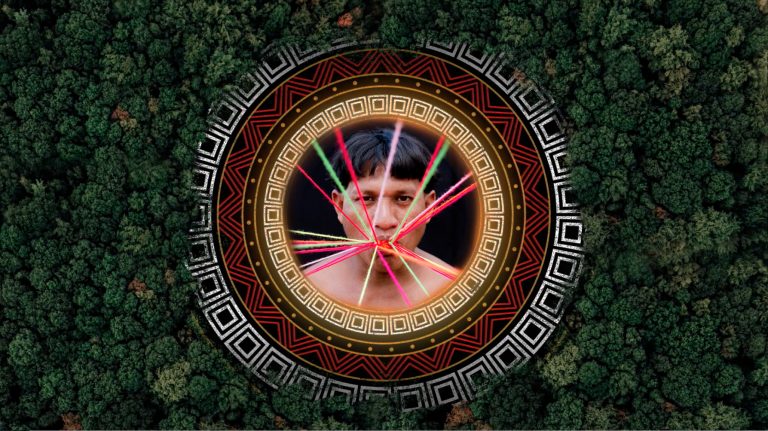Filmmaker Takumã Kuikuro, in collaboration with ACASAGRINGOCARDIA studio and People’s Palace Projects/QMUL, takes the Brazilian Amazon to the heart of the 17th International Architecture Exhibition – La Biennale di Venezia.
22 May, 2021- The immersive audio-visual installation OCA RED invites the world to connect to the Xingu way of life, celebrating indigenous, communal ways of living in harmony with the earth, and sharing a vision for all our futures. The Biennale asks: How will we live together? The video offers one answer, in the joy of rituals which have preserved the life and land of the Amazon region for over a thousand years. Watch the trailer:
The exhibition is also a cry for survival from filmmaker Takumã Kuikuro, for the indigenous people and the forest. The natural world around us is an extension of our life and is under threat – from climate change globally and from the loosening of environmental regulations in Brazil.
“We believe our relationship with the forest and our ability to live in harmony with the earth can offer important answers to some of the world’s pressing challenges. In our villages we know that whatever you do to the natural world you ultimately do to yourself. Understand us. Respect us. Value us. Our existence saves your life.” – Takumã Kuikuro
As forests burn, rivers dry up and the climate shifts, OCA RED enables visitors at the Biennale to connect their own past, present and future to the everyday life of indigenous villagers from the Brazilian Amazon. OCA RED is created by Brazilian designer Gringo Cardia with filmmaker Takumã Kuikuro, revealing the constant and evolving transition his people maintain between their ancestral past and the future for which they are preparing. As they engage and exchange with what most threatens to destroy them, the Kuikuro invite us to imagine how we might live together beyond the end of the world we have known so far.
A video installation of this ritual, curated by Takumã Kuikuro, Gringo Cardia and Paul Heritage will also be on display at the Future Assembly, curated by Olafur Eliasson’s Studio Other Spaces.
“The pandemic that delayed opening of the Biennale by one year has made OCA RED even more relevant. The video-installation highlights the harmonious relationship that indigenous people have with nature and their collective way of living. And when we think about architecture, we can learn from their ancestors about living together, leading us to question today’s unbalanced, suffering world.” – Gringo Cardia
To close the Biennale in November, two members of the Kuikuro will bring an experience of the annual Kuarup ritual that takes place annually, marking the passing of those lost during the year and celebrating the joy of life. This collaborative exhibition is a result of an arts exchange programme between indigenous and non-indigenous people in Brazil and the UK, organised by People’s Palace Projects.
“Museums and galleries have historically been heavily implicated in colonising Indigenous cultures and destroying the vital links between people, cultures and land. We believe these same institutions have a crucial role to play in raising international awareness about Indigenous peoples as essential protagonists in the fight against climate change and in resisting the destruction of their traditional ways of living.” – Paul Heritage, People’s Palace Projects
Visit OCA RED at La Biennale di Venezia official website
OCA RED has been produced by the Kuikuro people in partnership with ACASAGRINGOCARDIA and People’s Palace Projects (Queen Mary University of London)
- Curatorship: Takumã Kuikuro, Gringo Cardia and Paul Heritage
- Art Direction: Takumã Kuikuro, ACASAGRINGOCARDIA
- Production: Thiago Jesus, Jackson Tinoco and Corinne Mazzoli
- Video: Installation: Takumã Kuikuro, Kuikuro Cinema Collective and Glauber Vianna
- Sound: Nathaniel Mann and Takumã Kuikuro
OCA RED is funded by Queen Mary University of London Impact Accelerator Fund and has been made possible by the generous support of Sandhini Poddar and William Sargent.
The installation is a result of previous grant funding from UK Research and Innovation: Arts and Humanities Research Council (AHRC) and Economic and Social Research Council (ESRC).
People’s Palace Projects’ work is made possible by core funding from Arts Council England
